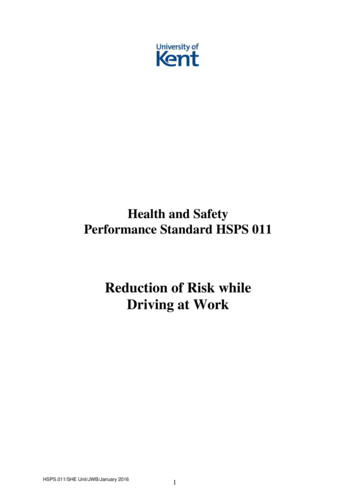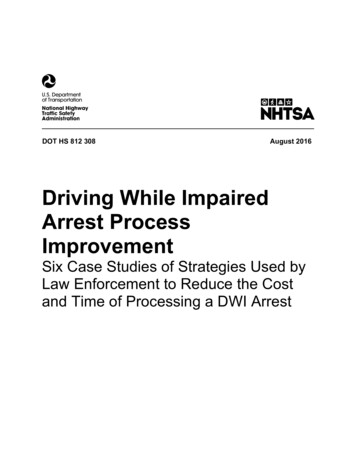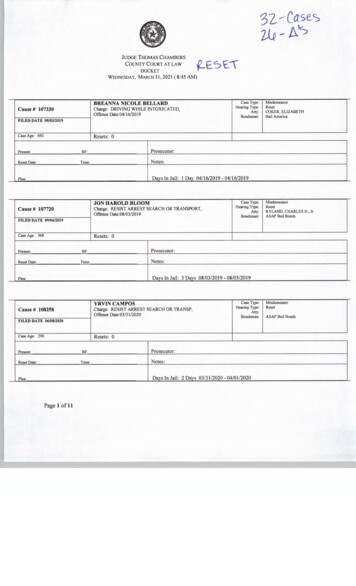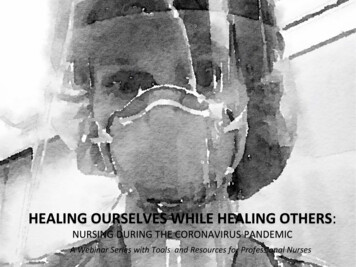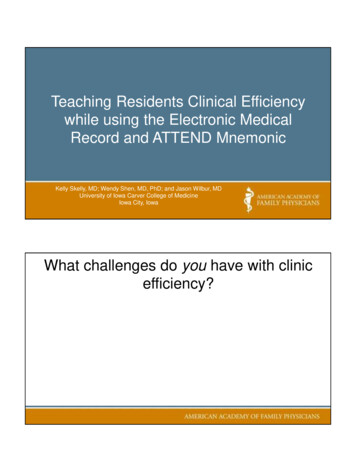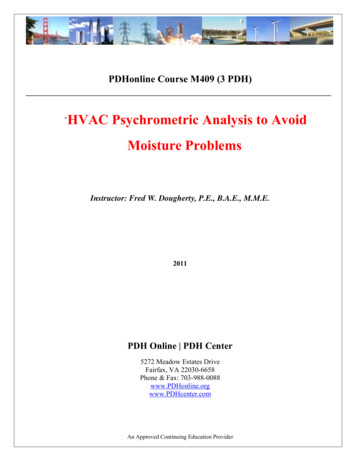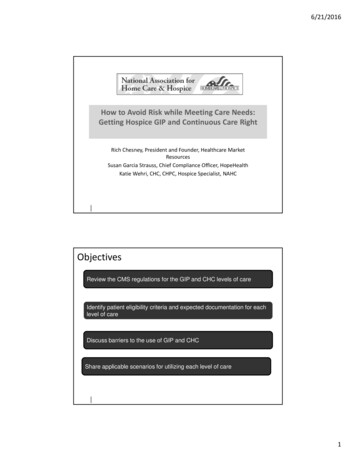
Transcription
6/21/2016How to Avoid Risk while Meeting Care Needs:Getting Hospice GIP and Continuous Care RightRich Chesney, President and Founder, Healthcare MarketResourcesSusan Garcia Strauss, Chief Compliance Officer, HopeHealthKatie Wehri, CHC, CHPC, Hospice Specialist, NAHCObjectivesReview the CMS regulations for the GIP and CHC levels of careIdentify patient eligibility criteria and expected documentation for eachlevel of careDiscuss barriers to the use of GIP and CHCShare applicable scenarios for utilizing each level of care1
6/21/2016The ConcernsARE PROVIDERS OFFERING THE FULL RANGE OFSERVICES?ARE PROVIDERS INAPPROPRIATELY ADMINISTERINGTHE BENEFIT?Referrals to S & C, Program Integrity2
6/21/2016What Does This Mean for Providers? Review PEPPER results– MAC– State– National Reasons for no GIP– Patient characteristics– Hospital/SNF relationships3
6/21/2016What Does This Mean for Providers? Review PEPPER results– MAC– State– National Reasons for no CHC– Patient characteristics– Staffing– Hospice inpatient unit– Relationship with hospital/SNFGIP & CHC Utilization4
6/21/2016Focus on GIPOversight focus on GIPOversight focus on proper use of thelevels of careTwo OIG Reports2013Medicare Hospice: Use of General InpatientCare2016Hospices Inappropriately Billed Medicare Over 250 Million for General Inpatient Care5
6/21/2016The FactsOIG Report 2013 – Medicare Hospice: Use of GeneralInpatient Care Based on GIP care provided in 2010 and 2011 Majority of GIP care provided in hospice inpatient units Hospices with inpatient units provided GIP care to more oftheir beneficiaries and for longer periods of time Some hospices did not provide any GIP Eight percent of all Medicare hospice dollars were for GIPcare 67% of this was for GIP care provided in hospiceinpatient unitsThe FactsOIG Report 2013 – Medicare Hospice: Use of GeneralInpatient Care One third of GIP stays had length of stay (LOS) 5 days 11% LOS 10 days or more A total of 23% of hospice beneficiaries received GIP carein 2011 71% of these patients received GIP care at thebeginning of their hospice election6
6/21/2016The FactsOIG Report 2013 – Medicare Hospice: Use of GeneralInpatient Care OIG recommended: Further review of long GIP stays and GIP in inpatientunits CMS should focus on hospices that do not provide GIP careand ensure that these hospices are providing beneficiariesaccess to needed levels of care at the end of their lives Suggested adopting a quality measure regarding hospices’ability to provide all hospice servicesThe FactsOIG Report 2016 – Hospices Inappropriately BilledMedicare Over 250 Million for General Inpatient Care Hospices billed one‐third of GIP stays inappropriately Hospices commonly billed for GIP when the beneficiary did not haveuncontrolled pain or unmanaged symptoms Ohio had many inappropriate GIP stays Hospices billed inappropriately for about half of GIP stays in SNFs Medicare sometimes paid twice for drugs for beneficiaries receiving GIP Hospices did not meet care planning requirements for 85 percent of GIPstays Hospices sometimes provided poor quality care and often did not provideintense services7
6/21/2016The FactsOIG Report 2016 – Hospices Inappropriately BilledMedicare Over 250 Million for General Inpatient CareRecommendations CMS increase its oversight of hospice GIP claims and review Part Dpayments for drugs for hospice beneficiaries CMS should ensure that a physician is involved in the decision to useGIP CMS conduct prepayment reviews for lengthy GIP stays CMS Increase surveyor efforts to ensure that hospices meet careplanning requirements CMS establish additional enforcement remedies for poor hospiceperformanceThe ConcernsARE PROVIDERS OFFERING THE FULL RANGE OFSERVICES?ARE PROVIDERS INAPPROPRIATELY ADMINISTERINGTHE BENEFIT?Referrals to S & C, Program Integrity8
6/21/2016Definitions In-patient care orservices is defined asshort term, general inpatient care provideddirectly by a hospiceprogram in their own inpatient facility, through acontract arrangementwith a licensed Medicarecertified long term carefacility, or hospital toprovide pain andsymptom managementthat cannot beaccomplished in anothersetting. Continuous HomeCare is provided in apatient’s home duringperiods of crisis. Aperiod of crisis is definedas a period in which apatient requirescontinuous care which isprimarily nursing care toachieve palliation ormanagement of acutemedical symptoms.17Regulations: General In-Patient CoP418.108 In-patient level of care must be made available for pain and symptommanagement as well as respite level of care in a participatingMedicare or Medicaid facility. A hospice providing in-patient care directly must meet regulationspecified in CoP 418.110. A hospice providing in-patient care under an arrangement agreementwithin a hospital or SNF must meet regulation specified in CoP418.110(b) and (e) regarding 24 hour nursing and patient areas.9
6/21/2016Service Level: In-Patient Hospices that provide in-patient care directly must provide24 hour nursing services that are sufficient to meet the totalneeds of the patient in accordance with the patient’s planof care. Each shift must include a registered nurse that providesdirect patient care. The medical director or his/her designee may conductregular on-site visits including daily visits if necessary.In-Patient Eligibility General inpatient care may be required for proceduresnecessary for pain control or acute or chronic symptommanagement that cannot feasibly be provided in homesettings. GIP under the hospice benefit is NOT equivalent to ahospital level of care. Skilled nursing care may be needed by a patient whosehome support has broken down if this breakdown makesit no longer feasible to furnish needed care in the homesetting.10
6/21/2016In-Patient EligibilityPain Requiring: Delivery of medication which may require skilled nursing care forcalibration, tubing change or site care/adjustment due to thecomplexity, nature of the medication and it’s delivery system. Frequent evaluation/assessments by nurse or physician. Aggressive treatment to control pain that cannot beaccomplished within the home setting. Frequent medication adjustments.In-Patient EligibilitySymptom changes: Sudden deterioration requiring intensive nursing intervention. Uncontrolled nausea or vomiting. Pathological fractures. Respiratory distress that becomes unmanageable. Transfusions for relief of symptoms. Traction and frequent re-positioning requiring more than onestaff member. Severe agitated delirium or anxiety or depression secondary toend-stage disease process.11
6/21/2016In-Patient EligibilityImminent death alone is not the criterion for the GIP levelof care! Symptom management that requires frequent skillednursing intervention as evidenced by mottling, change inrespiratory status and level of consciousness, etc. Symptoms related to imminent death which cannot bemanaged in the home setting.When GIP Is NOT Billable Caregiver breakdown, unless patient need meets criteria Patient admitted to hospice while in a hospital, SNF, orhospice inpatient unit, unless patient need meets criteria Unsafe/unclean home situation While awaiting nursing home placement Actively dying and not meeting the criteria for symptomsthat cannot be managed in another setting12
6/21/2016Criteria for Continued In-Patient Eligibility Hospice is working aggressivelyto develop a plan for safedischarge. Pain continues to require activetreatment and frequentassessment. Ongoing mental statuschanges that require activetreatment and frequentassessment. Acute symptoms havestabilized but death isimminent within a short Symptoms such as N/V,period of time as evidence byrespiratory distress, openmottling, change inlesions, or ongoing deteriorationrespiratory status and level ofrequire active treatment andconsciousness. Frequent skillfrequent assessment.nursing intervention isneeded to help family that isunable to cope.Requirements While Patient Receiving GIP IDG determines the level of care Patient does not need to change attending physicians Hospice inpatient cap Hospice-specific limitation Inpatient days billed to Medicare cannot exceed 20percent of the total hospice days billed to Medicare13
6/21/2016In-Patient Discharge Eligibility Reason for admission stabilized. Re-established family support system. Appropriate safe discharge plan has been developed. Transfer to another level of care (i.e. respite). All of these reasons should be reviewed as a whole andnot separately.In-Patient Documentation TipsDo Discharging planning begins on the first day of in-patientlevel of care and continues throughout the in-patient levelstay. Document the team’s effort to resolve patient problems atthe lowest level of care. Address discharge plans and why patient remains eligiblefor in-patient level of care. Explain why care must be provided in the in-patient settingand not at home e.g. “patient requires frequent RN/NP/MDassessment and titration of medication to control pain”.14
6/21/2016In-Patient Documentation TipsDo Describe services provided. Think of your note as a bill toMedicare. Each note must stand alone. Document the context and the events that led to the inpatient level of care. Document the failed attempts to control/manage symptomsprior to in-patient level of care admission. Document care that caregivers cannot manage at home.(frequent changes in medication/medication titration etc.)In-Patient Documentation TipsDo Document specific symptoms that are being addressed(uncontrolled n/v, new agitation/delirium). Describe failedattempts to manage these at home. Document progress/context/changes including:“symptomatic imminent death that cannot be managed athome or in SNF”. Document patient response to interventions provided onthe on the in-patient level of care (Were they effective? Arethey still effective?).15
6/21/2016In-Patient Documentation TipsDon’t Don’t use “patient is dying”, “end-of-life care”, “generaldecline” or “medication adjustment” to justify in-patientlevel of care unless you ALSO document why theseactions cannot take place in the home. Don’t document resolution of the precipitating events thatled to in-patient level of care without further documentingeligibility that maintains in-patient level of care status or,alternatively, documentation describing efforts to move thepatient to a more appropriate setting, i.e., SNF or home.Continuous Home Care16
6/21/2016Regulations: Continuous Home Care CoP418.204Periods of crisis. Nursing care may be covered on acontinuous basis for as much as 24 hours a day duringperiods of crisis as necessary to maintain an individual athome. Either homemaker or home health aide (also known ashospice aide) services or both may be covered on a 24-hourcontinuous basis during periods of crisis but care duringthese periods must be predominantly nursing care. A periodof crisis is a period in which the individual requires continuouscare to achieve palliation and management of acute medicalsymptoms.Regulations: Continuous Home Care CoP418.204Hospice inpatient unit – Q5006Hospital – Q5005SNF – Q5004Nursing facility – Q5003ALF – Q500217
6/21/2016Regulations: Continuous Home Care CoP418.204 A hospice may use contracted staff, if necessary, tosupplement hospice employees in order to meet the needsof patients under extraordinary or other non-routinecircumstances. Continuous care is not a highly specialized service,because while time intensive, it does not require highlyspecialized nursing skills.Requirements For Continuous Home Care The hospice must provide a minimum of 8 hours of care during a 24hour day, which begins and ends at midnight. This care need not be continuous, e.g., 4 hours could be provided inthe morning and another 4 hours in the evening. The care must be predominately nursing care provided by either anRN, an LPN, or an LVN. This means that more than half of the hours of care are provided by anRN, LPN, or LVN. Homemaker or hospice aide services may beprovided to supplement the nursing care. Disciplines such as medical social workers or pastoral counselors arenot included in the statutory definition of continuous care and are notcounted towards total hours of continuous care.18
6/21/2016Continuous Care Eligibility Need for care and or monitoring must be constant;remember a minimum of 8 hours in a 24 hour period. 51% of the continuous care hours must be skilled care. MSW and Pastoral Counselor visits may not beincluded as continuous care hours. Continuous care is an effort to de-escalate the immediatecrises and possibly avoid hospitalization. Continuous care is covered only as necessary to maintainthe terminally ill individual at home.Continuous Care EligibilitySymptom Management: Seizures Nausea/vomiting Uncontrolled painCollapse of family structure: Caregiver has been providing skilled care and change inpatient condition warrants nursing intervention as caregiverno longer can and/or wishes to provide care.19
6/21/2016When Continuous Care Is Not Allowed Actively dying and not meeting the criteria for symptoms that cannot bemanaged in another setting Caregiver breakdown, unless patient need meets criteria Unsafe home situation To maintain the patient in their own home While awaiting nursing home placementContinuous Care Documentation TipsDo Document the team’s effort to resolve patient problems atthe lowest level of care. Document specific symptoms that need to be controlled. Document what care needs are not being met and whythey require acute medical care Documentation should reflect that patient is at risk forhospitalization if symptoms and or care needs are notmanaged and or met. Document at least hourly20
6/21/2016Continuous Care Documentation TipsDon’t Include documentation time, hospice aide supervision, careplan changes in continuous care hours calculation Include non-allowed discipline time in continuous carehours calculation Discount aide hoursDocumentation TipsCreate a “snapshot” that will paint a picture of the patient’sneeds and what the care needs entail. The picture you paintis the picture Medicare will use to determine whether thislevel of care is appropriate and reimbursable.21
6/21/2016References IAHHC (2012) Hospice General Inpatient Criteria, Strauss and Wehri CFR Title 42- Public Health, Part 418-Hospice Care Electronic Code of FederalRegulations (2012) Hospice & Palliative Care Federation of Massachusetts (2008), The Hospice GeneralIn-Patient Level of Care; Criteria, Guidelines, Reimbursement and Contracting Medicare Benefit Policy Manual, 2c09.pdf CMS State Operations Manual, Appendix nce/Manuals/downloads/som107ap m hospice.pdf Medicare Claims Processing Manual, Chapter nce/Manuals/Downloads/clm104c11.pdfContact InformationQuestions, comments?Katie@nahc.org22
Continuous Home Care is provided in a patient’s home during periods of crisis. A period of crisis is defined as a period in which a patient requires continuous care which is primarily nursing care to achi
